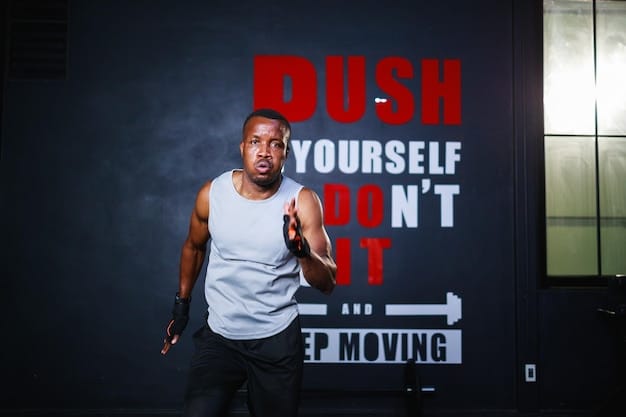Boost Your Mood: A 30-Day Physical Activity Challenge for Men

The connection between physical activity and mental well-being is undeniable, especially for men. This 30-day challenge incorporates simple exercises to uplift mood, reduce stress, and foster a healthier, happier lifestyle.
The link between **the connection between physical activity and mental well-being: a 30-day challenge for men** is not just a theory; it’s a proven path to a happier and healthier life. Let’s explore how moving your body can transform your mind and spirit.
Unveiling the Profound Link Between Physical Activity and Mental Well-being
Physical activity extends far beyond mere physical fitness. It’s a powerful tool in maintaining and improving mental well-being. The biochemical and psychological benefits are substantial, making exercise a cornerstone of a balanced lifestyle.
Understanding this connection can motivate men to incorporate regular physical activity into their routines, making them feel better both physically and mentally.
The Biochemical Benefits of Exercise
Exercise triggers a cascade of positive biochemical changes in the brain. These changes directly impact mental health, reducing symptoms of anxiety, depression, and stress.
- Endorphin Release: Endorphins act as natural mood elevators and pain relievers.
- Neurotransmitter Regulation: Exercise helps regulate neurotransmitters like serotonin and dopamine, crucial for mood, focus, and pleasure.
- Stress Hormone Reduction: Physical activity lowers cortisol levels, the primary stress hormone.

The Psychological Impact of Physical Activity
Beyond biochemical changes, exercise offers several psychological benefits that enhance mental well-being. These benefits stem from the sense of accomplishment, improved self-esteem, and social interaction.
Men often find that consistent physical activity leads to increased self-confidence, reduced stress, and a greater sense of overall well-being.
In conclusion, recognizing the dual benefits of physical activity provides a strong incentive for men to embrace a more active lifestyle, resulting in both physical and mental health improvements.
Crafting Your Personal 30-Day Mental Wellness Challenge
Creating a personalized 30-day mental wellness challenge is about identifying your specific needs and preferences. By tailoring the challenge to your individual circumstances, you’re more likely to stick with it and experience meaningful benefits.
Consider your goals for mental and physical well-being, and design a program that aligns with those goals.
Assessing Your Current Fitness Level
Before starting any new fitness routine, it’s essential to assess your current fitness level. This helps prevent injuries and ensures your activities are appropriately challenging.
- Basic Assessment: Include simple tests like push-ups, sit-ups, and a short walk to gauge your baseline fitness.
- Consult a Professional: If you have any underlying health conditions, consult a healthcare provider for personalized guidance.
- Realistic Goals: Set achievable goals based on your current abilities, gradually increasing the intensity and duration of your activities.
Selecting Activities You Enjoy
Choosing activities that you genuinely enjoy is crucial for long-term adherence. Exercise should be something you look forward to, not a chore you dread.
Explore different options, like team sports, solo exercises, or outdoor activities, to find what resonates with you.

Ultimately, creating a personalized challenge involves understanding your fitness level and choosing activities that bring you joy which makes it sustainable and effective.
Week 1: Establishing a Foundation of Movement
The first week of the 30-day challenge focuses on establishing a foundation of movement. This involves incorporating simple, low-impact activities into your daily routine to build consistency and momentum.
The goal is to lay the groundwork for a more active lifestyle without overwhelming your body.
Daily Walking Routine
Walking is an excellent starting point due to its accessibility and low impact. Aim for a brisk walk each day, gradually increasing the distance and pace.
Walking outdoors offers the added benefit of exposure to nature, which has been shown to reduce stress and improve mood.
Light Stretching and Flexibility Exercises
Incorporating light stretching and flexibility exercises helps improve joint mobility and prevent injuries. These exercises can be done at any time of day and require minimal equipment.
Consider focusing on major muscle groups, such as hamstrings, quads, and shoulders.
In summary, Week 1 should consist of daily walking and stretching to lay a solid foundation.
Week 2: Intensifying Your Physical Activity
Week 2 involves increasing the intensity of your physical activity. This means pushing yourself slightly harder than the previous week, either by increasing the duration, intensity, or frequency of your workouts.
Consistency is still key, but now it’s time to challenge your body and mind a bit further.
Introducing Bodyweight Exercises
Bodyweight exercises are a great way to build strength and endurance without needing any equipment. They can be done anywhere, making them a convenient option for busy men.
- Squats: Great for lower body strength and stability.
- Push-ups: Target chest, shoulders, and triceps.
- Plank: Strengthens core muscles for better posture and overall stability.
Exploring Different Forms of Cardio
To prevent boredom and work different muscle groups, explore various forms of cardio. Experiment with activities like jogging, cycling, swimming, or dancing.
Variety keeps things interesting and helps you find activities you truly enjoy.
Week 2 focuses on pushing you slightly harder without being overwhelmed. With the implementation of bodyweight exercises and different forms of cardio, be sure to listen to your body by not overdoing it.
Week 3: Focusing on Strength and Endurance
Week 3 is dedicated to building strength and endurance. This entails incorporating more challenging exercises and progressively increasing the weight or resistance you use.
The goal is to push your physical limits while maintaining proper form and preventing injuries.
Weightlifting and Resistance Training
Weightlifting and resistance training are essential for building muscle mass and increasing overall strength. Focus on compound exercises that work multiple muscle groups simultaneously.
Prioritize form over weight to prevent injuries and maximize the benefits of each exercise.
Longer and More Challenging Cardio Sessions
Increase the duration and intensity of your cardio sessions. This could involve running longer distances, cycling up steeper hills, or swimming faster laps.
The goal is to improve your cardiovascular fitness and endurance.
In Week 3, the goal is to increase strength and endurance through weights and challenging cardio for a more well-rounded physical challenge.
Week 4: Maintaining Momentum and Reflecting
The final week of the 30-day challenge is designed to maintain momentum and reflect on your progress. It’s about consolidating the habits you’ve built over the previous weeks and setting goals for the future.
This stage is crucial as it ensures the changes you’ve made become sustainable.
Active Recovery and Rest Days
Incorporate active recovery days into your routine to allow your body to repair and rebuild. Light activities like yoga or stretching can reduce muscle soreness and improve flexibility.
Ensure you also get adequate rest to prevent burnout and overtraining.
Setting Long-Term Fitness Goals
Reflect on your accomplishments and set realistic long-term fitness goals. This could involve participating in a race, achieving a specific weightlifting goal, or maintaining a consistent exercise routine.
Having clear goals will help you stay motivated and committed to your fitness journey.
| Key Point | Brief Description |
|---|---|
| 😊 Endorphin Release | Exercise boosts endorphins, natural mood elevators. |
| 💪 Bodyweight Exercises | Squats, push-ups, and planks build strength anywhere. |
| 🏋️ Weightlifting | Essential for building muscle mass and overall strength. |
| 🧘 Active Recovery | Yoga and stretching reduce soreness and improve recovery. |
Frequently Asked Questions
▼
Physical activity releases endorphins, regulates neurotransmitters, and reduces stress hormones, all contributing to improved mood and reduced anxiety and depression.
▼
The best exercises are the ones you enjoy and can consistently do. Options include walking, jogging, swimming, cycling, weightlifting, yoga, and dancing.
▼
Aim for at least 30 minutes of moderate-intensity exercise most days of the week. Consistency is key for experiencing significant mental health benefits.
▼
Consult with a healthcare provider or physical therapist to find exercises that are safe and appropriate for your specific condition. Modify exercises as needed.
▼
Set realistic goals, find an exercise buddy, track your progress, reward yourself for achieving milestones, and choose activities you genuinely enjoy.
Conclusion
Embarking on a 30-day physical activity challenge is a powerful step toward enhancing both your physical and mental well-being. Remember, the key is consistency, gradual progression, and tailoring the challenge to your individual needs and preferences. By embracing this journey, you’re not just building physical strength, but nurturing a healthier, happier, and more resilient mind.





